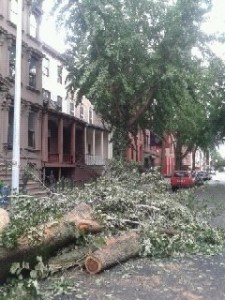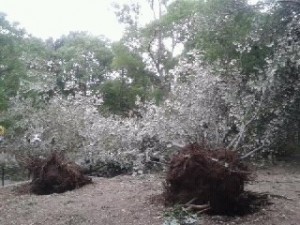Brooklyn after Hurricane Irene
Although these images might suggest otherwise, Hurricane Irene was not in a particularly intemperate mood when she passed over Brooklyn on Sunday, August 28. It could even be said that the preparations for her passage caused far greater inconvenience than did the swirling of her windy skirts. Perhaps the most remarkable thing about Irene, in fact, was the extent of the attention she attracted and the degree of concern she caused, locally and globally. I have been through many storms but I have never received as many messages as I did in these last few days (and here let me pause to say ‘thank you’ to everyone who wrote – I was really touched).
Kolkata has witnessed some of the most devastating storms of the last couple of centuries: it is the place where Henry Piddington invented the word ‘cyclone’ in the 1840s (why the word never caught on in the Americas and the Caribbean I cannot say – it is just a fact that ‘hurricane’ has always been their preferred term). Yet, despite their familiarity with storms, members of my family in Kolkata were almost in tears because of all they had read and seen about Hurricane Irene. It was something of a job to explain to them that Kolkata sees weather of much greater violence several times each year.
Yesterday, as I looked bemusedly at the gentle rain that Irene had sent down on Brooklyn, I found myself speculating about the reasons for the storm’s extraordinary notoriety. What does it say about our times? What does it presage? Here are some thoughts.
1. The concern caused by Irene is due, in no small part, to a deepening anxiety about global warming and unpredictable weather events (this is after all the year when New Zealand experienced its first tropical cyclone; the year when Queensland was hit by a devastating Category 5 storm, Cyclone Yasi).
2. Weather channels on television and weather-related sites on the net have turned the weather into a 24 hour spectacle: what could be more compelling, or more democratic, than a reality show in which everyone can compete? (It is a matter of some surprise to me that no one has thought to start a dedicated weather channel in India yet: with quizzes, competitions, crop forecasts etc. thrown in I am sure such a channel would find huge audiences – perhaps even larger than those which follow political talk shows).
3. The greater the threat the larger the audience: in other words, for the media, ratings depend upon the scale of the event. This creates an incentive to amplify the dimensions of the approaching event.
4. It has been widely remarked that intensive media coverage contributes to a culture of anxiety that feeds upon itself. In a situation (increasingly common worldwide) where imaginary threats often seem real, it is easy to see why a quantifiable and predictable threat would lead to a metastasizing of anxiety.
5. At a time when the efficacy of government is frequently questioned, emergency situations are increasingly a test of governmental performance.
6. Extreme weather events provide officials with opportunities, increasingly rare, where they command the full attention of the public and the media. It is only to be expected that this would bring a certain kind of infrastructure into being: situation rooms, briefings, press-conferences etc. Are these occasions exactly calibrated to public need? Or is there a degree of excess in them that might suggest that they are not just means to an end but ends in themselves, with their own dynamics and compulsions? No doubt someone will produce a study some day.
7. The fact that Hurricane Irene was destined to pass over New York was probably the single most important reason for its notoriety. This was due partly perhaps to the concentration of population in the area (but I need hardly point out that there are similar or even greater numbers of people in many regions where cyclones come and go without attracting much attention – southern China, Bangladesh, West Bengal, Vietnam, and the Phillipines). New York commands attention not only because it is a centre on which many peripheries converge: it has also become a screen on which people project their fears (this may have been true even before 9/11, but it is certainly more so now). In an age of anxiety, the city has become, so to speak, the epicentre of a global tectonics of unease.



Not to forget snow in Wellington (NZ) in August!!
Amitav you have a rare gift of putting words into an array that makes them so telling that even a topic like hurricane looks literary in your hands. You are doing justice to your talents…